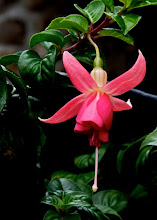
HUMPBACK WHALES
The humpback whale was given its common name because of the shape of its dorsal fin and the way it looks when its diving. Each whale has its own pattern on the underside of its tail flukes, which can be used like "fingerprints" to identify a particular whale.
Unique patterns on the underside of its tail flukes Humpbacks are found in all oceans from polar to tropical seas and follow fixed migration paths from their summer feeding grounds to warmer waters in the winter. Acrobatic humpbacks usually jump out of the water, stroke each other, and slap the water with their flippers and flukes. In feeding, they use baleen plates to strain small fish such as krill or herring, and plankton out of the water. Humpbacks are best known for their haunting vocalizations or "singing." They have a rich repertoire including frequencies beyond the threshold of human hearing with two basic functions, stunning or panicking fish shoals and communicating information to other herd members. Northern Hemisphere humpbacks have an average length (head to tail) of 49 to 52 feet, and southern humpbacks reach 60 feet. The average weight for a mature adult is between 35 to 65 tons. Their skin is black above, grooves white flukes with variable pattern below.
Even though the longevity of the humpbacks is around 95 years, they are now an endangered species, mainly due to toxic contamination, intensive oil and gas development in feeding grounds, habitat degradation, ship collisions and the still existing whaling industry.
Ecuadorian Whales.
Female humpbacks give birth every two or more years. Pregnancies last for 12 months. The calves nurse for eight to eleven months. Every year between June and September the coast of Ecuador witnesses a magical show, the mating of the Humpback whales. These giant mammals start in the Antartica their long journey to the mild waters of the Ecuadorian ocean. When they reach their destination, these 50 feet long mammals jump in and out of the water trying to call their mates attention. This ritual may last for several weeks, and one year later their offsprings are born in Ecuadorian waters.
Whale watching has become an interesting activity along the entire coast of Ecuador, especially in Puerto Lopez, a small fishing village which has still kept its charm. After an hours´s boat ride, whales are seen exhaling large streams of water and graciously showing their fins. Whale watchers can even name the whale by taking a picture of its tail and sending it to the Ecuadorian Government (if it hasn’t been registered previously). Tourists complete their whale experience when they visit the information center in Puerto Lopez, where interesting data about these humpback whales is available. This visit and many others programs in the Andean Region are now organized for 100% vegetarian tourists, who enjoy the pristine nature and its exquisite vegetarian cuisine.
Get involved, travel veggie.

